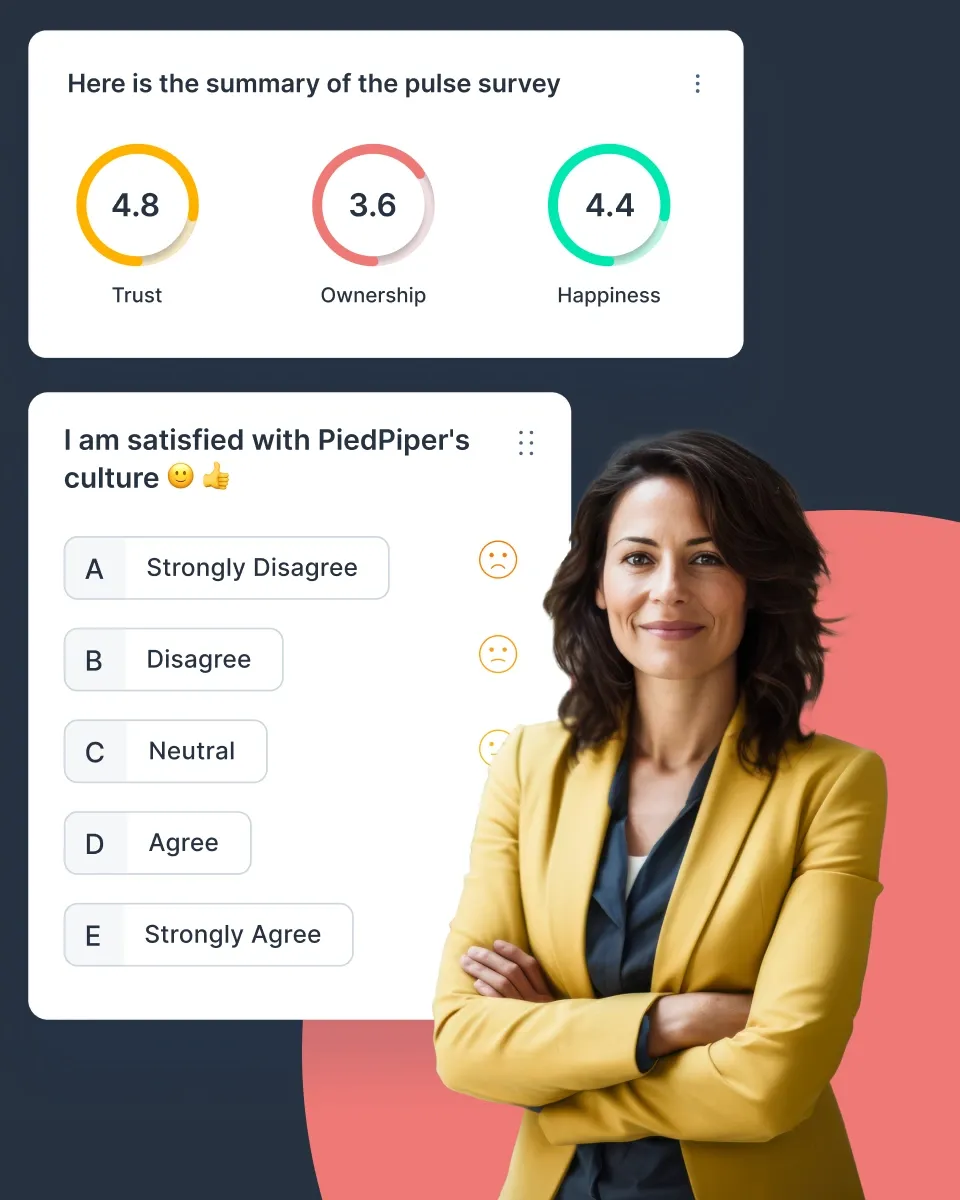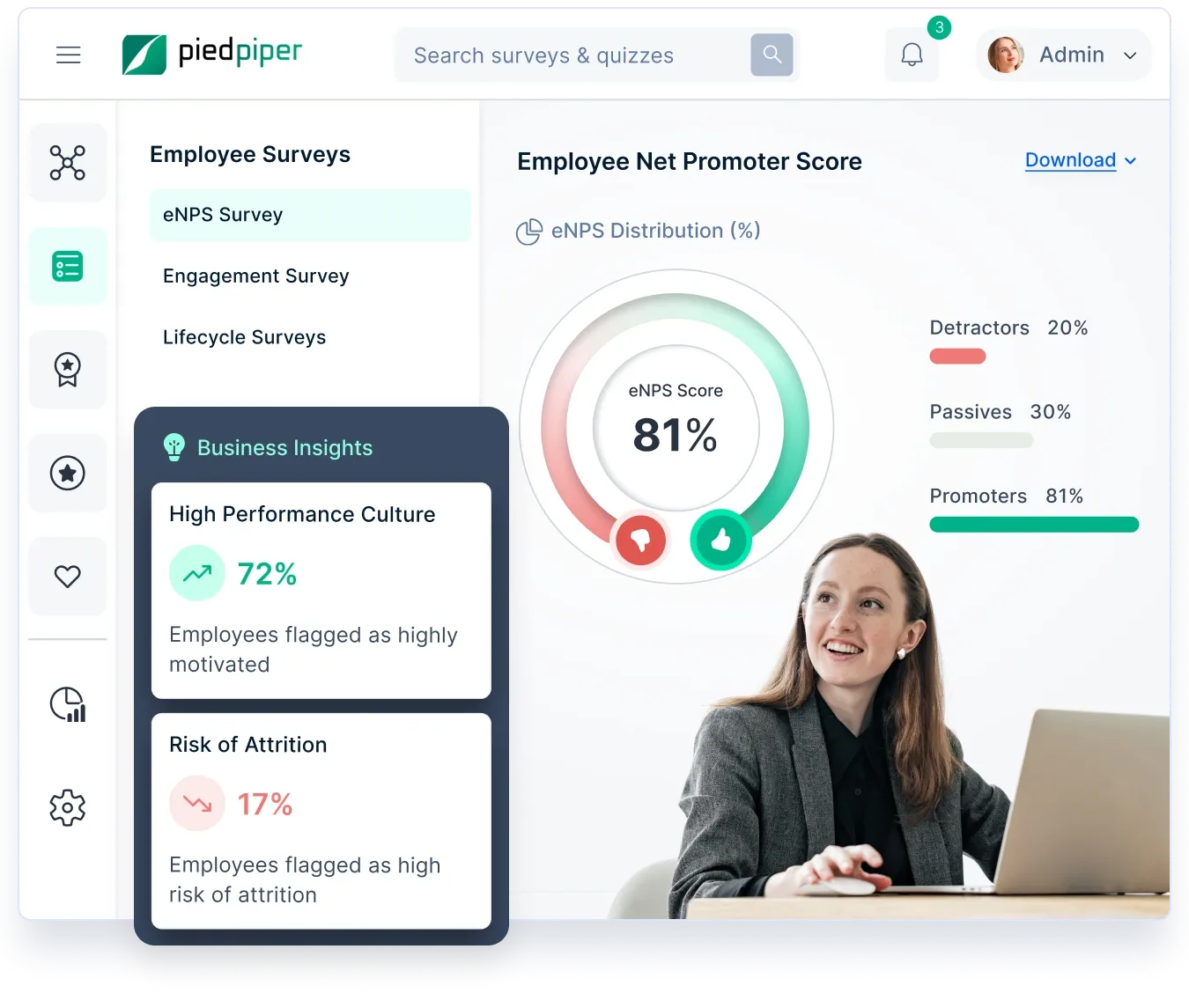الدليل الكامل للتغذية الراجعة بزاوية 360 درجة: العملية، والأسئلة، والأمثلة على التغذية الراجعة بزاوية 360 درجة
توفر مراجعة التغذية الراجعة بزاوية 360 درجة تقييماً شاملاً من خلال جمع الرؤى من المديرين والأقران والمرؤوسين والعملاء. يغطي هذا الدليل عملية التغذية الراجعة بزاوية 360 درجة، والأسئلة الأساسية التي يجب طرحها، وأمثلة عملية لمساعدة المؤسسات على تحسين أداء الموظفين.

في هذه الصفحة
- ما هي التغذية الراجعة 360 درجة؟
- ما الذي يجب تضمينه في التغذية الراجعة 360 درجة؟
- ما أهمية إجراء استبيان التغذية الراجعة بزاوية 360 درجة؟
- التغذية الراجعة 360 درجة مقابل مراجعات الأداء
- أيهما يجب أن تستخدم؟
- ما مدى فعالية التغذية الراجعة بزاوية 360 درجة؟
- القيود التي يجب مراعاتها
- أفضل الممارسات لتشغيل برنامج فعال للتغذية الراجعة من 360 درجة
- استبيان شامل للتغذية الراجعة من 360 درجة
- أمثلة على التغذية الراجعة 360 درجة
- تعزيز التغذية الراجعة من 360 درجة مع Empuls
- استنتاج
يُعد استبيان الملاحظات التقييمية بزاوية 360 درجة أحد أكثر الطرق فعالية للحصول على تقييم شامل لأداء الموظف. وعلى عكس المراجعات التقليدية، التي تعتمد فقط على مدخلات المدير، تجمع المراجعات بزاوية 360 درجة رؤى من الأقران والمرؤوسين والمديرين وحتى العملاء لتوفير رؤية شاملة لنقاط قوة الموظف ونقاط ضعفه وتأثيره في مكان العمل.
من خلال استخدام أسئلة تقييم 360 درجة جيدة التنظيم، يمكن للمؤسسات تقييم مهارات التواصل، وفعالية القيادة، والعمل الجماعي، وقدرات حل المشكلات. لا تعزز هذه العملية الوعي الذاتي والنمو المهني فحسب، بل تقلل أيضًا من التحيز وتوفر انعكاسًا أكثر دقة لمساهمات الموظف.
في هذا الدليل، سنستكشف في هذا الدليل أمثلة على التغذية الراجعة بزاوية 360 درجة، والأسئلة الرئيسية التي يجب طرحها في استبيان التغذية الراجعة بزاوية 360 درجة، وأفضل الممارسات لضمان الحصول على رؤى قابلة للتنفيذ. سواء كنت تطبق التغذية الراجعة بزاوية 360 درجة لأول مرة أو تتطلع إلى تحسين نهجك، ستساعدك هذه المقالة على فهم قيمتها وتأثيرها على تطوير الموظفين.
ما هي التغذية الراجعة 360 درجة؟
التغذية الراجعة بزاوية 360 درجة هي طريقة لتقييم الأداء حيث يتلقى الموظفون التغذية الراجعة من مصادر متعددة، بما في ذلك المديرين والأقران والمرؤوسين وحتى العملاء. توفر عملية المراجعة الشاملة هذه منظورًا شاملاً حول نقاط قوة الموظف، ومجالات التحسين، والتأثير العام في مكان العمل.
على عكس مراجعات الأداء التقليدية من أعلى إلى أسفل، تشجع الملاحظات التقييمية بزاوية 360 درجة على تقديم رؤى بناءة من مختلف مستويات المؤسسة، مما يساعد الموظفين على التطور المهني وتحسين التعاون والتوافق مع أهداف الشركة.
ما الذي يجب تضمينه في التغذية الراجعة 360 درجة؟
يجب أن تغطي عملية التغذية الراجعة ذات التنظيم الجيد 360 درجة جوانب متعددة من أداء الموظف وسلوكه ونموه المهني. وعادةً ما تتضمن التغذية الراجعة من المديرين والأقران والمرؤوسين وأحيانًا العملاء، مما يوفر نظرة شاملة لنقاط القوة ومجالات التحسين.
- مهارات التواصل: ما مدى فعالية الموظف في نقل الأفكار والاستماع إلى الآخرين؟
- التعاون والعمل الجماعي: ما مدى نجاحهم في العمل مع الزملاء والمساهمة في خلق بيئة جماعية إيجابية؟
- القيادة وصنع القرار: هل هم فعالون في توجيه الآخرين واتخاذ المبادرة واتخاذ القرارات السليمة؟
- الأداء الوظيفي والإنتاجية: هل يلبون التوقعات، ويقدمون عملاً عالي الجودة، ويظلون خاضعين للمساءلة؟
- القدرة على التكيف وحل المشكلات: ما مدى جودة تعاملهم مع التغيير والتحديات والمواقف غير المتوقعة؟
- أخلاقيات العمل والموثوقية: هل هم جديرون بالثقة ومبادرون ومتسقون في مسؤولياتهم؟
- الذكاء العاطفي: ما مدى قدرتهم على إدارة المشاعر، والتعامل مع ردود الفعل، وبناء علاقات قوية في مكان العمل؟
- التطوير الوظيفي والتعلم: هل هم منفتحون على التعلُّم وصقل المهارات والنمو الشخصي؟
ويضمن تضمين هذه المجالات في التغذية الراجعة بزاوية 360 درجة تقييمًا شاملًا وثاقبًا يساعد الموظفين على النمو والتحسن في أدوارهم.
ما أهمية إجراء استبيان التغذية الراجعة بزاوية 360 درجة؟
يوفر استبيان التقييم الشامل 360 درجة تقييماً شاملاً لأداء الموظف من خلال جمع رؤى من مصادر متعددة، بما في ذلك المديرين والأقران والمرؤوسين والعملاء. وعلى عكس مراجعات الأداء التقليدية، فإن هذه الطريقة تقلل من التحيز وتوفر منظوراً أكثر شمولاً. فهي تساعد الموظفين على فهم نقاط قوتهم وتحديد مجالات التحسين وتعزيز علاقاتهم في مكان العمل.
1. تقدم رؤية شاملة للأداء
يضمن جمع التغذية الراجعة من مصادر مختلفة إجراء تقييم أكثر توازناً وعدلاً لمساهمات الموظف، بدلاً من الاعتماد فقط على وجهة نظر المدير.
2. يشجع على النمو والتطور المهني
يتلقى الموظفون رؤى قيّمة حول أدائهم، مما يسمح لهم بتحديد أهداف التطوير الشخصي والعمل على المجالات التي تحتاج إلى تحسين.
3. تحسين التواصل والعمل الجماعي
يكتسب الموظفون فهماً أفضل لكيفية تأثير أفعالهم على زملائهم، مما يؤدي إلى تحسين التعاون، وتعزيز العلاقات، وتوفير بيئة عمل أكثر إيجابية.
4. الحد من التحيز في تقييمات الأداء
من خلال دمج التغذية الراجعة من مصادر متعددة، يمكن للمؤسسات تقليل التحيزات الشخصية وضمان تقييم أكثر دقة وعدالة للموظفين.
5. تعزيز فعالية القيادة
يمكن للمدراء والقادة تحديد نقاط القوة ومجالات التحسين في أسلوبهم القيادي، مما يساعدهم على بناء علاقات أقوى مع فرقهم وتحسين عملية اتخاذ القرار.
يساعد إجراء استبيان التغذية الراجعة بزاوية 360 درجة المؤسسات على تعزيز ثقافة الشفافية والمساءلة والتحسين المستمر. ويؤدي ذلك إلى تحسين مشاركة الموظفين، وارتفاع مستويات الأداء، وتقوية العلاقات في مكان العمل
التغذية الراجعة 360 درجة مقابل مراجعات الأداء
تُعد كل من مراجعات التقييمات بزاوية 360 درجة ومراجعات الأداء التقليدية أدوات أساسية لتقييم أداء الموظفين، ولكنها تختلف بشكل كبير في نهجها وغرضها ونتائجها. ويمكن أن يساعد فهم هذه الاختلافات المؤسسات في اختيار الطريقة الصحيحة لتطوير الموظفين وتقييم أدائهم.
أيهما يجب أن تستخدم؟
- استخدم مراجعات التغذية الراجعة 360 درجة عندما يكون الهدف هو تطوير مهارات القيادة وتعزيز التواصل وتحسين العمل الجماعي. هذه الطريقة هي الأنسب للنمو الشخصي والتطوير المهني.
- استخدم مراجعات الأداء التقليدية عند التركيز على إنتاجية الموظف، وتحقيق الأهداف، والمكافآت القائمة على الأداء مثل الترقيات أو تعديل الرواتب.
يمكن للمؤسسات الاستفادة من الجمع بين الطريقتين، وذلك باستخدام التغذية الراجعة بزاوية 360 درجة لنمو الموظفين ومراجعات الأداء للتقييمات المنظمة، مما يضمن اتباع نهج شامل لإدارة المواهب.
ما مدى فعالية التغذية الراجعة بزاوية 360 درجة؟
تُعد عملية التغذية الراجعة بزاوية 360 درجة فعالة للغاية عند تنفيذها بشكل صحيح، حيث توفر رؤية شاملة لأداء الموظف ومهاراته وتأثيره في مكان العمل.
من خلال جمع التغذية الراجعة من مصادر متعددة، بما في ذلك المديرين والأقران والمرؤوسين والعملاء، يمكن للمؤسسات الحصول على تقييم أكثر دقة وحيادية لنقاط قوة الفرد ومجالات التحسين.
1. يشجع التقييمات الشاملة
نظرًا لأن التغذية الراجعة تأتي من وجهات نظر متعددة، فإنها توفر تقييمًا أكثر شمولاً وموضوعية مقارنةً بالمراجعات التقليدية من أعلى إلى أسفل.
2. تعزيز الوعي الذاتي والنمو
يكتسب الموظفون رؤى حول أدائهم وتفاعلاتهم في مكان العمل، مما يساعدهم على التعرف على مجالات التحسين وتطوير مهارات جديدة.
3. تحسين فعالية القيادة والإدارة
يتلقى المدراء ملاحظات بنّاءة حول أسلوبهم القيادي، مما يسمح لهم بتعديل نهجهم ودعم فرقهم بشكل أفضل.
4. تعزيز العلاقات في مكان العمل والعمل الجماعي
يفهم الموظفون كيف تؤثر أفعالهم على الآخرين، مما يؤدي إلى تحسين التعاون والتواصل وحل النزاعات.
5. تقلل من التحيز والذاتية
غالبًا ما تعتمد المراجعات التقليدية على وجهة نظر واحدة، والتي يمكن أن تكون متحيزة. تضمن التغذية الراجعة بزاوية 360 درجة تقييماً أكثر توازناً من خلال دمج وجهات نظر متعددة.
6. تعزيز مشاركة الموظفين والاحتفاظ بهم
عندما يشعر الموظفون بأن صوتهم مسموع ويتلقون ملاحظات قابلة للتنفيذ، فمن المرجح أن يظلوا متحمسين وملتزمين بأدوارهم.
القيود التي يجب مراعاتها
في حين أن التغذية الراجعة بزاوية 360 درجة فعالة، إلا أنه يجب إجراؤها بشكل صحيح لتجنب المزالق الشائعة. وينبغي للمؤسسات أن تضمن ما يلي:
- عدم الكشف عن الهوية والسرية لتشجيع التعليقات الصادقة.
- أهداف واضحة حتى يفهم الموظفون الغرض من العملية.
- المتابعة العملية لمعالجة الملاحظات وتنفيذ التحسينات.
عند استخدامها بشكل استراتيجي، تساعد التغذية الراجعة بزاوية 360 درجة الموظفين على النمو، وتعزز القيادة، وتعزز ثقافة التحسين المستمر، مما يجعلها أداة قوية للنجاح الشخصي والمؤسسي.

أطلق العنان للإمكانات الكاملة للتغذية الراجعة بزاوية 360 درجة
احصل على رؤى شاملة حول أداء الموظفين من خلال استطلاعات رأي منظمة ومجهولة وقائمة على البيانات ومبنية على 360 درجة. يساعدك Empuls على جمع الملاحظات وتحليلها والتصرف بناءً عليها لدفع عجلة النمو والتحسين المستمر.
أفضل الممارسات لتشغيل برنامج فعال للتغذية الراجعة من 360 درجة
اعثر على الدليل الإرشادي لأفضل الممارسات لبرامج التغذية الراجعة بزاوية 360 درجة التي يمكن أن تصبح أداة الأداء الأكثر فعالية في شركتك.
1. اختر مجالات تركيزك
سيعطيك برنامج التعليقات بزاوية 360 درجة رؤى من جميع أنحاء شركتك. في الوقت نفسه ، تكون التعليقات عديمة الفائدة ما لم تتصرف بناء عليها. لا يمكنك العمل على كل شيء في وقت واحد ، لذلك تحتاج إلى تحديد فئات مختلفة من التعليقات ذات الأولوية الأعلى أو الأقل من غيرها ، مثل الحاجة إلى تحفيز القوى العاملة الألفية أو تحسين التواصل الداخلي.
سيساعدك اختيار مجالات التركيز أيضًا عند اختيار الأسئلة التي تطرحها على الأشخاص.
على سبيل المثال، إذا كنت تركز على ضمان التنوع في مكان العملفستختلف أسئلتك عما قد تكون عليه إذا كنت تحاول تعزيز الكفاءة التشغيلية. تذكر أنه يمكنك معالجة الملاحظات الأخرى لاحقاً.
أنت بحاجة إلى معرفة ما يجب استهدافه أولاً لضمان حصولك على تلك النتائج المبكرة التي ستشجع بقية المؤسسة على أخذ العملية على محمل الجد.
2. إنشاء ثقافة التغذية الراجعة
لا ينبغي إعفاء أي موظف، بما في ذلك القادة أنفسهم، من تلقي الملاحظات.
"القيادة هدف متحرك، وستظل كذلك دائمًا. إذا كنت ترغب في أن تصبح قائدًا أفضل، فكن مرتاحًا للتغيير. وإذا أردت أن تصبح قائدًا، فتعلم أن تفكر كقائد. فكر في الناس، وفكر في التقدم وفكر في الأمور غير الملموسة." - جون سي ماكسويل، مؤلف كتاب القائد بزاوية 360 درجة.
خلق ثقافة التغذية الراجعة يفيد كلاً من الأفراد الذين يعملون لديك والشركة ككل. كما أنه يساعد على تحسين كيفية تقديم منتجك وتحسين تجربة العملاء من خلال خلق ثقافة يكون فيها الأفراد أكثر انخراطًا في العمل الذي يقومون به، ويرجع ذلك جزئيًا إلى أنهم يعلمون أنهم يتعلمون أشياء جديدة ويحسنون مهاراتهم بشكل شبه يومي.
3. اطرح الأسئلة الصحيحة
كما هو الحال مع أي عملية جمع للبيانات، تحتاج إلى الحصول على المعلمات الصحيحة إذا كنت تريد أن تكون النتائج صحيحة. يتعلق برنامج التغذية الراجعة من 360 درجة بطرح الأسئلة الصحيحة على الأشخاص.
إذا كانت مؤسستك كبيرة بما فيه الكفاية، يمكنك اختبار برنامجك مع مجموعة عينة صغيرة من الموظفين لمعرفة ما إذا كانت أسئلتك تؤدي إلى الإجابات التي تبحث عنها. إذا لم يكن الأمر كذلك، فقد حان الوقت لتغيير الأسئلة.
يمكن أن يساعد ذلك في البدء بالنظر إلى مجالات تركيزك وتحديد الموظفين الذين ستتحدث إليهم. ستختلف الأسئلة التي ستطرحها على الإدارة العليا اختلافا كبيرا عن تلك التي ستطرحها على الموظفين المبتدئين.
فكر في طرح أسئلة حول مهارات القيادة، ومهارات التواصل، والإبداع، والعمل مع فريق، وغير ذلك. تذكر أن الحصول على الكثير من البيانات أفضل من الحصول على القليل منها ولكن زيادة عدد نقاط البيانات سيزيد أيضًا من الوقت الذي يستغرقه تنفيذ البرنامج.
4. المتابعة مع الناس
إن الوصول إلى البيانات لن يوصلك إلا حتى الآن ، وإذا فشلت في متابعة المعلومات التي تجمعها ، فلن يوصلك برنامج التعليقات بزاوية 360 درجة إلى أي مكان. خذ الوقت الكافي لمشاركة التعليقات مع الموظفين ثم العمل معهم لوضع خطة عمل لمعالجة هذه الملاحظات.
بمجرد وضع خطة ، تأكد من الالتزام بها والتحقق مرة أخرى مع الموظفين بمرور الوقت.
إن اتباع هذه العملية سيساعدك أيضاً في المرة القادمة التي تدير فيها برنامجاً للتغذية الراجعة لأنه سيكون لديك نقاط بيانات لمقارنة النتائج الجديدة بها. إذا قمت بتحديد المشكلات وتوصيلها بشكل صحيح ومتابعتها مع الموظفين بمرور الوقت، فمن المفترض أن ترى تحسناً ملحوظاً في أدائهم بمرور الوقت.
5. اجعلها منتظمة
لا يمكننا التأكيد بما فيه الكفاية هنا على أن الاتساق هو المفتاح. من خلال جعل برامج التغذية الراجعة المستمرة هي القاعدة الجديدة في شركتك، فإنك تساعد في خلق ثقافة التغذية الراجعة التي ذكرناها في النقطة الثانية.
من خلال القيام بهذه الجهود بانتظام، فإنك تساعد في ضمان أن يعرف الجميع في الشركة ما يمكن توقعه ويرغبون في تمنيه بدلاً من أن يفاجئهم مفاجأة غير مرحب بها.
كما لو أن ذلك لم يكن كافيًا، فإن جعل برامج التغذية الراجعة أكثر انتظامًا يمكن أن يساعد الأشخاص على التغلب على نقاط ضعفهم بسرعة أكبر بدلاً من تركهم يرتكبون نفس الأخطاء لأشهر أو حتى سنوات متتالية. كما أوضحنا في النقطة الأخيرة، إذا جعلت برامج الملاحظات التقييمية منتظمة، يمكنك تتبع التحسينات التي طرأت خلال الفترة الفاصلة.
6. استخدمه باهتمام نحو النمو الشخصي للموظفين
يتمثل أحد التحديات التي تواجه نشر برامج التغذية الراجعة بزاوية 360 درجة في الحصول على التأييد والمشاركة من الموظفين. في بعض الشركات، يرجع ذلك إلى قلق الموظفين من أن تقديم ملاحظات صادقة حول زملائهم في العمل قد يصل إلى المراجعات السنوية ويؤثر على ما إذا كان الموظفون سيحصلون على مكافآت أو حتى يعاقبون.
أظهرت الدراسات أن جيل الألفية/جيل الشباب يرغبون في الحصول على التغذية الراجعة والتدريب بنسبة 50% أكثر من الأجيال الأخرى في القوى العاملة.
يجب أن تبذل قصارى جهدك لتشجيع موظفيك على الثقة بالعملية. وهذا يعني توصيل ما سيتم استخدام الملاحظات من أجله والتأكد من أنك تحترم تلك الاتفاقات. فالثقة هي جزء حيوي من العملية، وإذا قمت بكسر هذه الثقة، فسوف تجد صعوبة في جمع بيانات ورؤى دقيقة.
7. اختبار وتحسين
يقولون أن الجنون هو فعل الشيء نفسه مرارًا وتكرارًا وتوقع نتائج مختلفة. وينطبق ذلك بشكل خاص عند نشر برنامج التغذية الراجعة بزاوية 360 درجة. من الجيد تغيير الأمور واختبار مختلف الأساليب وتحديد العناصر التي تجعل عملية التغذية الراجعة أكثر كفاءة.
يقولون أيضًا أن التنوع هو نكهة الحياة، وهناك سبب لذلك. يساعدك إجراء التغييرات والتحسينات على أساس مستمر على تحقيق مكاسب هامشية، مما يعني إجراء تحسينات طفيفة تضيف المزيد من التحسينات الكبيرة مع مرور الوقت.
التزم بما ينجح ثم انتقل إلى اختبار شيء آخر لضمان حصولك على أكبر قدر من الملاحظات القابلة للتنفيذ.
استبيان شامل للتغذية الراجعة من 360 درجة
يوفر استبيان التغذية الراجعة 360 درجة المنظم جيدًا رؤى قيمة حول نقاط قوة الموظف، ومجالات التحسين، والتأثير العام في مكان العمل. من خلال جمع الملاحظات من المديرين والأقران والمرؤوسين والعملاء، يمكن للمؤسسات إجراء مراجعة عادلة وشاملة لملاحظات 360 درجة تدعم النمو المهني وتطوير الفريق.
1. التواصل والتعاون
- ما مدى فعالية تواصل الموظف مع الزملاء وأصحاب المصلحة؟
- هل يستمع الموظف بفاعلية ويستجيب بشكل بنّاء للملاحظات؟
- إلى أي مدى يساهم الموظف في مناقشات الفريق وجلسات العصف الذهني؟
- هل يقوم الموظف بتوصيل الأفكار بوضوح وإيجاز؟
- ما مدى فعالية الموظف في تكييف أسلوب تواصله مع الجماهير المختلفة؟
2. القيادة وصنع القرار
- ما مدى فعالية الموظف في قيادة المشاريع أو المبادرات؟
- هل يتخذ الموظف قرارات مستنيرة تحت الضغط؟
- ما مدى كفاءة الموظف في تقديم التوجيه والدعم للزملاء؟
- هل يقوم الموظف بتفويض المهام بشكل مناسب وتمكين الآخرين من تولي زمام الأمور؟
- ما مدى فعالية الموظف في إلهام وتحفيز فريقه؟
3- أخلاقيات العمل والمساءلة
- هل يتولى الموظف ملكية مهامه ومسؤولياته؟
- ما مدى فعالية الموظف في الوفاء بالمواعيد النهائية وتقديم عمل عالي الجودة؟
- هل يُظهر الموظف الموثوقية والكفاءة المهنية في دوره الوظيفي؟
- إلى أي مدى يقوم الموظف بترتيب الأولويات وإدارة عبء العمل الخاص به؟
- هل يأخذ الموظف زمام المبادرة في تحديد المشكلات ومعالجتها؟
4. حل المشكلات والقدرة على التكيف
- ما مدى جودة تعامل الموظف مع التحديات والمواقف غير المتوقعة؟
- هل يظهر الموظف إبداعاً في حل المشاكل المتعلقة بالعمل؟
- ما مدى فعالية تكيف الموظف مع التغيرات في مكان العمل؟
- هل يظل الموظف هادئاً وموجهاً نحو الحلول تحت الضغط؟
- إلى أي مدى يوازن الموظف بين المخاطرة والتفكير الاستراتيجي؟
5. الذكاء العاطفي والسلوك في مكان العمل
- ما مدى جودة تعامل الموظف مع النقد البناء؟
- هل يحافظ الموظف على سلوك إيجابي ومحترم في مكان العمل؟
- ما مدى فعالية الموظف في إدارة النزاعات في مكان العمل؟
- هل يظهر الموظف التعاطف والمراعاة تجاه الزملاء؟
- ما مدى قدرة الموظف على التعامل مع الضغوط والحفاظ على رباطة جأشه في المواقف الصعبة؟
6. النمو والتطور المهني
- هل يبحث الموظف بنشاط عن فرص التعلم والتطوير؟
- ما مدى انفتاح الموظف على الملاحظات والتحسين الذاتي؟
- هل يبادر الموظف إلى توسيع مهاراته ومعرفته؟
- ما مدى فعالية الموظف في تطبيق ما تعلمه في عمله؟
- هل يدعم الموظف نمو وتطور أقرانه؟
7. إدارة العملاء وأصحاب المصلحة
- ما مدى فعالية الموظف في إدارة علاقاته مع العملاء وأصحاب المصلحة؟
- هل يتعامل الموظف مع مخاوف العملاء وملاحظاتهم بشكل احترافي؟
- ما مدى جودة تمثيل الموظف للمنظمة في التفاعلات الخارجية؟
- هل يبحث الموظف بشكل استباقي عن طرق لتحسين رضا العملاء؟
- ما مدى فعالية الموظف في الموازنة بين الأولويات الداخلية والخارجية؟
تساعد هذه الأمثلة على الملاحظات التقييمية بزاوية 360 درجة المؤسسات على جمع رؤى شاملة وبناءة وقابلة للتنفيذ، والتي تدفع عجلة تطوير الموظفين ونجاح الفريق. تضمن المراجعة المنظمة للتغذية الراجعة بزاوية 360 درجة حصول الموظفين على تغذية راجعة شاملة لتعزيز مهاراتهم في التواصل والقيادة وحل المشكلات

الوصول إلى قوالب استبيان التقييمات الجاهزة للاستخدام بزاوية 360 درجة
اجعل التغذية الراجعة بزاوية 360 درجة سلسة من خلال قوالب استبيانات مصممة بخبرة. اجمع الرؤى من وجهات نظر متعددة واحصل على ملاحظات قابلة للتنفيذ لتعزيز تطوير الموظفين.
أمثلة على التغذية الراجعة 360 درجة
يوفر استبيان التغذية الراجعة بزاوية 360 درجة رؤى شاملة حول أداء الموظف من خلال جمع التغذية الراجعة من المديرين والأقران والمرؤوسين والعملاء. ولجعل التغذية الراجعة أكثر قابلية للتنفيذ، من الضروري تنظيم الردود بطريقة إيجابية أو سلبية أو بناءة.
أمثلة على الملاحظات الإيجابية
- "أنت تنقل أفكارك بوضوح وتضمن فهم الجميع للنقاط الرئيسية في الاجتماعات. إن قدرتك على الاستماع الفعال والمشاركة في المناقشات تعزز تعاون الفريق."
- "مهاراتك القيادية ملهمة. أنت تضع توقعات واضحة، وتفوض المهام بفعالية، وتدعم فريقك في تحقيق أهدافهم."
- "أنت تتعامل مع مشاريع متعددة بكفاءة وتفي بالمواعيد النهائية باستمرار. تُعد مهاراتك في إدارة الوقت ميزة كبيرة للفريق."
- "مهاراتك في حل المشكلات استثنائية. فأنت تحلل التحديات بعناية وتقترح حلولاً عملية تفيد الفريق بأكمله."
- "أنت تعزز بيئة عمل إيجابية وشاملة من خلال كونك ودودًا وداعمًا لزملائك."
- "إن قدرتك على التكيف جديرة بالثناء. أنت تتقبل التغيير بحماس وتساعد في توجيه الآخرين خلال التحولات بسلاسة."
- "إن رغبتك في مساعدة الآخرين ومشاركة خبراتك تعزز أداء الفريق بشكل عام."
- "أنت تدير النزاعات في مكان العمل بشكل احترافي وتضمن أن تظل المناقشات مثمرة ومركزة على الحلول."
- "أنت تقدم باستمرار عملاً عالي الجودة مع الاهتمام الكبير بالتفاصيل. يشكل التزامك بالتميز مثالاً يحتذى به للآخرين."
- "أنت تُظهر إحساسًا قويًا بالمساءلة وتتحمل مسؤولياتك، مما يضمن إنجاز المهام بفعالية."
أمثلة على التغذية الراجعة السلبية
- "يمكن أن يكون تواصلك أكثر وضوحاً، حيث يواجه بعض أعضاء الفريق صعوبة في فهم تعليماتك. ومن شأن تبسيط رسالتك أن يحسن التعاون."
- "غالبًا ما تفوتك المواعيد النهائية، مما يؤثر على سير عمل الفريق بشكل عام. يمكن أن تساعد إدارة الوقت بشكل أفضل في تحسين الكفاءة."
- "قد يكون أسلوبك في القيادة غير متناسق في بعض الأحيان، مما يؤدي إلى الارتباك داخل الفريق. إن توفير توجيه أوضح من شأنه أن يعزز توافق الفريق."
- "تميل إلى العمل بشكل مستقل ولا تشرك الآخرين دائمًا في اتخاذ القرارات، مما يؤثر على العمل الجماعي. ومن شأن زيادة التعاون أن يكون مفيداً."
- "تواجه صعوبة في التكيف عند حدوث تغييرات، مما يجعل من الصعب على الفريق التكيف بسرعة. ومن شأن التحلي بمزيد من المرونة أن يساعد في التعامل مع الأولويات المتغيرة."
- "قد تبدو ردودك على الملاحظات في بعض الأحيان دفاعية، مما يجعل من الصعب على الآخرين تقديم مدخلات بناءة."
- "غالبًا ما تتأخر في الرد على رسائل البريد الإلكتروني والرسائل، مما يؤدي إلى إبطاء تقدم المشروع. ومن شأن تحسين الاستجابة للاتصالات أن يفيد الفريق."
- "تعاني أحيانًا من صعوبة في ترتيب أولويات المهام، مما يؤدي إلى الاندفاع في اللحظة الأخيرة. ومن شأن التخطيط المسبق أن يساعد في إدارة أعباء العمل بفعالية أكبر."
- "قد تبدو تفاعلاتك مع زملائك في بعض الأحيان وكأنها معاملات وليس تعاوناً. ومن شأن تعزيز العلاقات في مكان العمل أن يحسن ديناميكيات الفريق."
- "يمكن أن تكون مترددًا في اتخاذ المبادرة، مما يؤدي أحيانًا إلى ضياع الفرص. أن تكون أكثر استباقية يمكن أن يؤثر بشكل إيجابي على مساهماتك."
أمثلة على الملاحظات البناءة
- "عروضك التقديمية غنية بالمعلومات، ولكن إضافة المزيد من العناصر المرئية يمكن أن تجعلها أكثر جاذبية وأسهل في المتابعة."
- "أنت تساهم بأفكار قيّمة خلال الاجتماعات، ولكن السماح للآخرين بمشاركة وجهات نظرهم قبل الرد من شأنه أن يشجع على المزيد من التعاون."
- "إن قدرتك على إدارة مشاريع متعددة أمر مثير للإعجاب، ولكن تحديد أولويات أوضح يمكن أن يساعد في تقليل الضغط في اللحظة الأخيرة وتحسين الكفاءة."
- "لديك مهارات تقنية قوية، ولكن تحسين قدرتك على شرح المفاهيم المعقدة بمصطلحات أبسط من شأنه أن يفيد الفريق."
- "إن قيادتك فعالة، ولكن تقديم المزيد من التقدير المتكرر لأعضاء فريقك يمكن أن يزيد من رفع الروح المعنوية."
- "أنت تتولى مسؤولية عملك، ولكن طلب المساعدة عند الحاجة يمكن أن يجعل المشاريع تسير بسلاسة أكبر ويقلل من التوتر غير الضروري."
- "إن ملاحظاتك للآخرين قيّمة ولكن تقديمها بلهجة أكثر دعماً قد يشجع على قبولها والعمل بها بشكل أكبر."
- "أنت تركز بشكل كبير على مهامك، ولكن المشاركة في المزيد من المبادرات المشتركة بين الفرق يمكن أن تساعد في توسيع نطاق تأثيرك داخل الشركة."
- "أنت تتعاملين مع التحديات بشكل جيد، ولكن مشاركة الدروس المستفادة من المواقف الصعبة يمكن أن تساعد الآخرين على الاستفادة من خبراتك."
- "إن مهاراتك في حل المشكلات قوية، ولكن تخصيص بعض الوقت للتفكير في طرق بديلة قبل اتخاذ القرارات قد يؤدي إلى نتائج أفضل."
تساعد أمثلة التغذية الراجعة 360 درجة هذه على ضمان أن تكون التغذية الراجعة محددة وقابلة للتنفيذ وداعمة، مما يسمح للموظفين بتحسين الأداء وتعزيز التعاون والنمو المهني.
تعزيز التغذية الراجعة من 360 درجة مع Empuls

تساعد عملية التغذية الراجعة بزاوية 360 درجة المنظمة بشكل جيد المؤسسات على اكتساب فهم كامل لأداء الموظفين من خلال جمع الرؤى من المديرين والأقران والمرؤوسين والعملاء. ومع ذلك، بدون الأدوات المناسبة، يمكن أن تكون التغذية الراجعة غير متسقة أو متحيزة أو يصعب التصرف بناءً عليها.
باستخدام Empuls يمكن للمؤسسات تبسيط عملية مراجعة التغذية الراجعة 360 درجة من خلال
- إجراء استطلاعات رأي آلية ومجهولة المصدر وقابلة للتخصيص بزاوية 360 درجة.
- جمع رؤى شاملة من وجهات نظر متعددة لإجراء تقييم شامل.
- استخدام التحليلات القائمة على الذكاء الاصطناعي لتحديد نقاط القوة ومجالات التحسين وفرص التطوير.
- تتبع تقدم الموظفين وتعزيز النمو والمشاركة المستمرة.
من خلال الاستفادة من Empuls يمكن للشركات تحويل الملاحظات إلى أفعال، ومساعدة الموظفين على التطور، وتحسين التعاون، ودفع عجلة النجاح المؤسسي.
ابدأ رحلتك مع Empuls في الحصول على تقييمات 360 درجة!
استنتاج
من المحتمل أن يصبح برنامج التغذية الراجعة 360 درجة المصمم بشكل جيد أقوى أداة يمكن لشركتك الوصول إليها. والأفضل من ذلك أنه سيستمر في التحسن بمرور الوقت بينما تتعلم ما يصلح وما لا يصلح وبينما تستمر في تحسين شركتك.
في بعض الحالات، يصنع الفارق بين شركتين ويمنح إحداهما الميزة التنافسية التي تحتاجها للارتقاء إلى قمة الصناعة. والسؤال الوحيد هو ما إذا كنت مستعداً لبذل الجهد والاستفادة من ذلك أم أنك ستجلس مكتوف الأيدي وتسمح لمنافسيك بتجاوزك.





